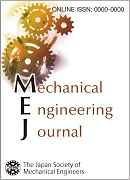4 巻, 1 号
選択された号の論文の18件中1~18を表示しています
- |<
- <
- 1
- >
- >|
Speed-up and Sustainable Technology for Railway
-
2017 年 4 巻 1 号 p. 17preface1
発行日: 2017年
公開日: 2017/02/15
PDF形式でダウンロード (627K) -
2017 年 4 巻 1 号 p. 16-00467
発行日: 2017年
公開日: 2017/02/15
[早期公開] 公開日: 2017/01/11PDF形式でダウンロード (3875K) -
2017 年 4 巻 1 号 p. 16-00455
発行日: 2017年
公開日: 2017/02/15
[早期公開] 公開日: 2016/12/02PDF形式でダウンロード (9378K) -
2017 年 4 巻 1 号 p. 16-00459
発行日: 2017年
公開日: 2017/02/15
[早期公開] 公開日: 2016/12/21PDF形式でダウンロード (2428K) -
2017 年 4 巻 1 号 p. 16-00486
発行日: 2017年
公開日: 2017/02/15
[早期公開] 公開日: 2017/02/02PDF形式でダウンロード (1771K) -
2017 年 4 巻 1 号 p. 16-00454
発行日: 2017年
公開日: 2017/02/15
[早期公開] 公開日: 2017/02/07PDF形式でダウンロード (1191K) -
2017 年 4 巻 1 号 p. 16-00498
発行日: 2017年
公開日: 2017/02/15
[早期公開] 公開日: 2017/01/06PDF形式でダウンロード (4981K) -
2017 年 4 巻 1 号 p. 16-00516
発行日: 2017年
公開日: 2017/02/15
[早期公開] 公開日: 2017/01/31PDF形式でダウンロード (6749K) -
2017 年 4 巻 1 号 p. 16-00473
発行日: 2017年
公開日: 2017/02/15
[早期公開] 公開日: 2016/11/22PDF形式でダウンロード (3918K)
Fluids Engineering
-
2017 年 4 巻 1 号 p. 16-00500
発行日: 2017年
公開日: 2017/02/15
[早期公開] 公開日: 2016/12/16PDF形式でダウンロード (2248K) -
2017 年 4 巻 1 号 p. 16-00217
発行日: 2017年
公開日: 2017/02/15
[早期公開] 公開日: 2017/01/13PDF形式でダウンロード (7235K)
Thermal, Engine and Power Engineering
-
2017 年 4 巻 1 号 p. 16-00320
発行日: 2017年
公開日: 2017/02/15
[早期公開] 公開日: 2016/12/26PDF形式でダウンロード (3353K)
Computational Mechanics
-
2017 年 4 巻 1 号 p. 16-00268
発行日: 2017年
公開日: 2017/02/15
[早期公開] 公開日: 2016/12/13PDF形式でダウンロード (6591K)
Dynamics & Control, Robotics & Mechatronics
-
2017 年 4 巻 1 号 p. 16-00226
発行日: 2017年
公開日: 2017/02/15
[早期公開] 公開日: 2016/12/19PDF形式でダウンロード (5091K) -
2017 年 4 巻 1 号 p. 16-00202
発行日: 2017年
公開日: 2017/02/15
[早期公開] 公開日: 2016/12/19PDF形式でダウンロード (1462K) -
2017 年 4 巻 1 号 p. 16-00482
発行日: 2017年
公開日: 2017/02/15
[早期公開] 公開日: 2016/12/26PDF形式でダウンロード (4367K) -
2017 年 4 巻 1 号 p. 16-00397
発行日: 2017年
公開日: 2017/02/15
[早期公開] 公開日: 2017/01/27PDF形式でダウンロード (2629K) -
2017 年 4 巻 1 号 p. 16-00306
発行日: 2017年
公開日: 2017/02/15
[早期公開] 公開日: 2017/01/27PDF形式でダウンロード (3338K)
- |<
- <
- 1
- >
- >|
